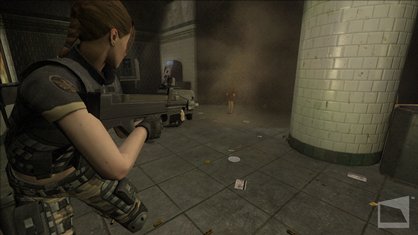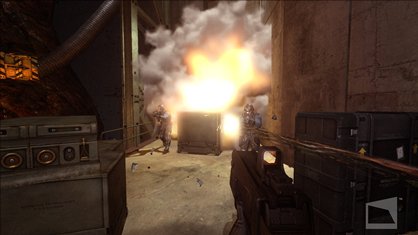The events of Project Origin promise to bring the player closer – physically and psychologically – to Alma than the flittering twitches its predecessor, FEAR allowed. “You play Michael Beckett,” enthuses John Mulkey, Project Origin’s lead designer. “You’re going in to rescue Aristide, the president of Armacham – the woman who restarted Project Origin and wakened Alma. It starts before the end of the first game, when you (as Point Man, the original game’s protagonist) were headed into the containment facility and Wade released Alma and you had to destroy the facility to control her.”
This means, mid-point in Project Origin, you’ll get to witness the massive explosion that punctuated the end of FEAR, and get the chance to extend your war into the burning streets of a newly bombed town. In some ways, Project Origin is similar to its predecessor. The guns have a similar look and the distressingly named Penetrator is back, albeit with a couple of tweaks. Mulkey explains that the gun was as popular in-house as it was with players. “Our principle art lead’s favourite thing to do was to go slow-motion, crouch under a guy, shoot him in the chin and pin him to the ceiling. Horrifying, but kinda like a pinata.”

The interface has a cleaner, curvier feel to it and the numbered health and armour has been replaced with the console standard of health regeneration. You still have the powers to slow time – although how you’re able to achieve this remains unexplained, for now. An early scene showing you being operated on while Aristide looks on perhaps giving the strongest clue. The game feels different in other ways. Monolith have engaged with their community – their “Name Your Fear” competition was the source of this game’s title. Another thing that the fans wanted and are getting, are mechs.
Monolith have strong form in mech combat – 10 years ago, Shogo: Mobile Armor Division won a devoted following with its manga-themed mecha gunplay. Shogo is still played today, but would be far better remembered if it hadn’t been released at the same time as Half-Life. So it feels like the inclusion of mechs is more a cock-eyed tribute to the meaty metal of Shogo than the tense sinew we loved about FEAR. A large part of the code we played was this new, mechanised combat. The power feels great – the terrain that felt solid before suddenly crumbles under the miniguns and rockets of your suit. Men become ants and other mechs feel oddly tiny, making you feel more impervious than you actually are. Rockets steadily chip away at the suit’s armour, and you’re a sitting flesh duck when you’re forced to evacuate. As much fun as this is, it’s hardly any definition of scary. Exhilarating, yes. Cool, possibly. But being the biggest bastard on the battlefield is the polar opposite of atmospheric terror. In the absence of any evidence of claustrophobic corridors and hallucinations, we had to ask Mulkey if this isn’t going against the grain of what FEAR was about.

“FEAR is all about the crazy chaos of combat. It’s going into this crowded room, throwing in a grenade and hitting slow-mo.” He’s right, of course – even with the nods to Japanese horror films, FEAR was as much an action movie as anything else. But excellent AI aside, it’s the horror and atmosphere that sticks with you, years on. Surely they’ll be recreating that? “We’ll still have the tension-building elements, and all that stuff,” says Mulkey, with the practised vagueness of a man who knows that he’s sailing close to forbidden topics. “In the first game we introduced the vocabulary of what we were using. You had the scary little girl, it was all creepy and she’d startle you. Now we’ve established that, we can’t really use the same tricks again.”
Sign up to the GamesRadar+ Newsletter
Weekly digests, tales from the communities you love, and more


